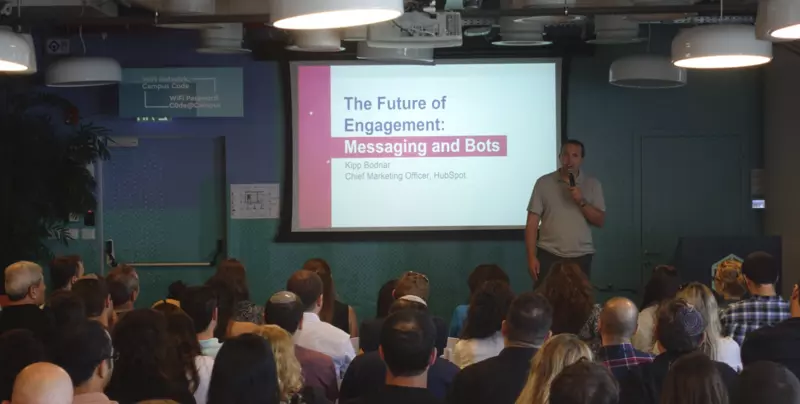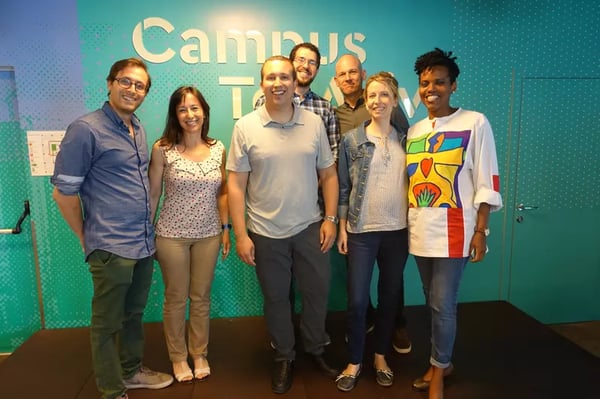
To anyone working in the digital world today, one thing is clear: the consumer is in control. They want to interact with your company when they want to and they want to do it in real-time.
These exacting demands make it harder than ever to deliver a great experience and engage with prospective customers as well as the media.
Recently, Penguin Strategies had the opportunity to host HubSpot CMO, Kipp Bodnar, for a morning of insights on the Future of Engagement. Kipp explored the pitfalls and satisfaction of getting started with messaging and bots as well as ideas on how to evolve your go-to-market strategy to become real-time at scale.
The event was held at the Google Campus in Tel Aviv on Tuesday, May 29. Thank you to those who were able to participate, but if you couldn’t attend, we have provided the salient points from Kipp’s discussion
Marketing has a tendency to mess things up. When you consider email, as an example, marketers have taken it to the extreme and changed it. People are skeptical of marketing because marketers want to change things—and it’s not always for the better. Companies are also making it harder for people to buy things from them.
The friction between buyers and sellers has never been greater. Companies today rely heavily on online marketing instead of making human connections, and are interested only in limited subsets of buyers, reducing the number of potential customers.
Bodnar also thinks that email has been messed up by marketers in the past ten years. The whole concept of email has radically diminished the opportunities for human interactions.
Companies basically want email recipients to click on a link in an email and never really talk to them. Bodnar understands why this has evolved but thinks it misses the real intent that companies should create—allowing for interactions between prospects and customers.
People today have no tolerance for waiting. People used to have to manage only one email inbox but today we all manage several inboxes every day. Add to that the fact that people have no tolerance for waiting and the interaction dynamic changes.
Most companies think that buyers are waiting on their sales reps which is a flawed theory. What they need to realize that if someone is interested in your business, they’ll come to your website to take some action. If you’re not available or can’t accommodate their needs immediately, they’ll move on.
Buyers want you to be where they are.
In the old “one inbox world,” one-sided communication was acceptable, but today companies should explore how to scale communications and make them available on an immediate basis. Companies should make it really easy for people to engage with them to ask questions and make purchases.
Engagement platforms are changing. Facebook messenger is an especially effective tool, with five or six times better engagement rate than email.
In the messaging world, the inbox is where the customer is. If the customer is in
Quite simply, email is great for broadcasting messages that require longer sentences but chats and messaging are perfect for real-time, quick conversations.
Automated email essentially means more emails while automation in messaging translates to bots which provide communication with
Social messaging tools are more popular than core social media platforms. Facebook Messenger, for example, has greater use than the Facebook platform in general.
More companies are willing to use a messaging solution to gain more customers. Interestingly, there hasn’t been anything like messaging solutions which millions of people use, for marketers to adopt as an important tactic.
Using messaging channels skews to a younger demographic but all age groups have shown some level of adoption. The main reason it’s being so widely accepted is
Messaging

Also, with messaging, there’s no option to not respond which is a big thing for marketers and companies. With email, it’s easy to ignore anybody, but messaging puts the customer in your space and you’re forced to respond.
In a messaging world, companies must have the ability to communicate with people, either through chatbots or humans with those skill sets. The bottom line is that it’s simply unacceptable to not be there when someone is ready to engage with your company.
Messaging is a new operating system. Websites were the new tools for a long time but now messaging tools bring us chatbots which are kind of like the new websites of the messaging era. Companies will build chatbots to do the same thing they built websites for such as informing people about your company and products.
Chatbots are the automated messaging solutions which will become popular because they are an economical solution. Companies like HubSpot and Facebook use chatbots all over the world creating a shift in behavioral momentum.
You need a way to coordinate chatbots across your team. Collaborative efforts will place the appropriate person with the customer so that the engagement is smooth and satisfying for the customer.
If you’re working with Facebook ads, you can actually send someone directly to
In a HubSpot test of signing people up via messenger, people really appreciated the novelty of the process. Bodnar feels that it’s those types of unique interactions that make or break a brand.
There are two kinds of bots in the world. Bots are going to create better conversations through utility bots and transactional bots. Utility bots provide opportunities to do research while transactional bots can help you make purchases with accompanying sales follow-up messaging.
You have the best success with building a bot when you have a very focused use case. Don’t make the parameters too broad or ask too much of a new bot. Technology development in the future will allow for a broader scope of
We can help with bot development. Penguin Strategies can help marketers and companies utilize the HubSpot marketing automation tool to install chatbots on their sites with full support.
Penguin Strategies, a Diamond HubSpot partner, is a leading B2B marketing agency focusing on helping technology companies generate leads that matter. Our agency offers a range of marketing services such as inbound marketing strategy, automation, content writing, email campaigns,

by Perry Nalevka on June 04, 2018
CEO of Penguin Strategies







